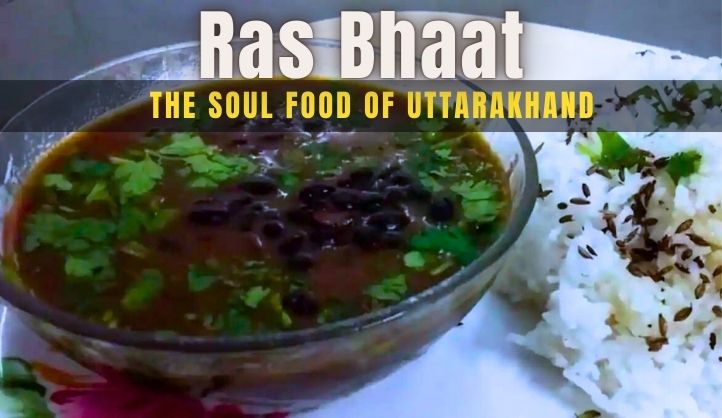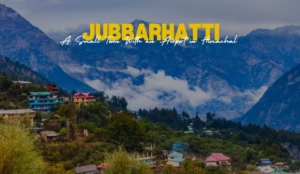Carved into the foothills of the mighty Himalayas, Uttarakhand is a land of breathtaking beauty. Lush valleys, cascading waterfalls, and snow-capped peaks paint a picture of serenity, while a rich cultural tapestry unfolds beneath the watchful gaze of the mountains. This cultural heritage extends far beyond breathtaking landscapes and vibrant festivals, weaving its magic into the very soul of the region’s cuisine.
Among the culinary treasures of Uttarakhand lies Ras Bhaat, a seemingly simple dish that holds within its depths a story of resilience, resourcefulness, and the warmth of home. Literally translating to “soup” (Ras) and “rice” (Bhaat), Ras Bhaat is much more than the sum of its parts. It’s a symphony of textures and flavors, a comforting embrace on a chilly mountain evening, and a testament to the enduring spirit of the Pahadi people, the inhabitants of the Himalayan foothills.
A Legacy Steeped in Tradition
The origins of Ras Bhaat lie shrouded in the mists of time, intertwined with the history and traditions of Uttarakhand. Life in the Himalayas has always been a challenge, with harsh winters and limited access to resources. The Pahadi people, known for their adaptability and self-sufficiency, developed a cuisine that celebrated local produce and maximized its potential. Ras Bhaat emerged as a way to utilize seasonal vegetables and legumes, particularly the humble soybean, a rich source of protein and essential nutrients.
This frugal approach wasn’t just about survival; it was a celebration of the land’s bounty. Each ingredient in the Ras Bhaat carries a story. Lentils, a staple across India, find a new expression in this dish. Black or white soybeans, often the stars of the show, contribute a unique textural depth and a subtle sweetness. Urad dal (black gram) and gahat (horse gram) add heartiness and a spectrum of earthy tones. Local vegetables like spinach, radish greens, and bottle gourd, depending on the season, lend vibrant pops of color and freshness.
The Art of Slow Cooking
The magic of Ras Bhaat unfolds not just in the selection of ingredients but also in the meticulous preparation process. Traditionally cooked in an iron kadhai (wok) over a wood fire, the dish allows time for the flavors to develop slowly and deeply. The lentils are soaked overnight, softening them and making them easier to digest. This soaking also aids in extracting their nutrients, making Ras Bhaat not just delicious but also incredibly nourishing.
As the fire crackles, the soaked lentils are simmered in water, slowly releasing their essence. Chopped vegetables, if included, join the dance, adding their vibrant flavors to the broth. The aroma that fills the kitchen is a beguiling blend of earthy lentils, fragrant spices, and the subtle smokiness imparted by the wood fire.
Spice Symphony:
The heart of the Ras isn’t just the lentils; it’s the delicate play of spices that awakens the senses. Cumin seeds, with their warm, slightly bitter notes, add an earthy base. Coriander powder, with its citrusy and floral aroma, brings a touch of brightness. Turmeric, the golden goddess of Indian cuisine, lends its vibrant hue and potent anti-inflammatory properties. A touch of red chili powder adds a gentle heat, customizable to individual preferences.
This tapestry of spices is then often finished with a tadka, a technique where ghee or oil is heated until it smokes, and then infused with fragrant spices like mustard seeds and dried red chilies. This tempering adds a layer of complexity and a visual flourish as the vibrant red oil glistens on the rich brown stew.
The Perfect Union
No story of Ras Bhaat is complete without mentioning its perfect companion – Bhaat, the simple yet essential rice. Steamed to fluffy perfection, the rice serves as a blank canvas for the flavors of the Ras. Each spoonful is a delightful combination – the creamy lentil stew enveloping the pillowy rice, creating a comforting and textural contrast. A dollop of ghee or a drizzle of mustard oil adds a touch of richness, and a sprinkle of chopped fresh coriander leaves lends a burst of freshness to the dish.
A Dish for All Seasons
While Ras Bhaat shines brightest on a chilly Himalayan evening, its versatility transcends the seasons. In the sweltering summers, it’s often enjoyed at room temperature, providing a light and nourishing meal. During the harvest season, pumpkins and other seasonal vegetables find their way into the Ras, creating delightful variations.
Conclusion: A Culinary Adventure Awaits
Ras Bhaat, the humble yet soul-stirring stew of Uttarakhand, is a testament to the region’s rich heritage and the resourcefulness of its people. From its simple origins to its comforting flavors, it’s a dish that warms the body and heart. So, the next time you crave a culinary adventure, embark on a journey to the Himalayas and savor the comforting embrace of Ras Bhaat. Who knows, it might just become your new favorite comfort food!
FAQs About Ras Bhaat: Your Short Guide
1. What are the key ingredients in Ras Bhaat?
The base of Ras Bhaat features soybeans (black or white), often accompanied by other lentils like urad dal and gahat. Vegetables like spinach, radish greens, or bottled gourd may be included depending on the season. Spices like cumin, coriander, turmeric, and red chili powder add depth and warmth.
2. How is Ras Bhaat traditionally cooked?
Traditionally, Ras Bhaat is simmered in an iron kadhai over a wood fire. Lentils are soaked overnight and then cooked with vegetables and spices. A tadka with ghee and fragrant spices adds the finishing touch.
3. What is served with Ras Bhaat?
Ras Bhaat is typically enjoyed with fluffy white rice. A dollop of ghee, mustard oil, or chopped fresh coriander leaves may be added for extra flavor.
4. Is Ras Bhaat vegetarian?
Yes, Ras Bhaat is a vegetarian dish made with lentils, vegetables, and spices.
5. Are there variations of Ras Bhaat?
Yes, variations exist. Seasonal vegetables like pumpkins may be used, and the spice level can be adjusted to preference. The dish can be enjoyed hot or at room temperature, depending on the season.





